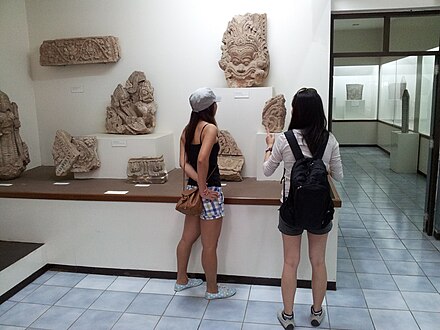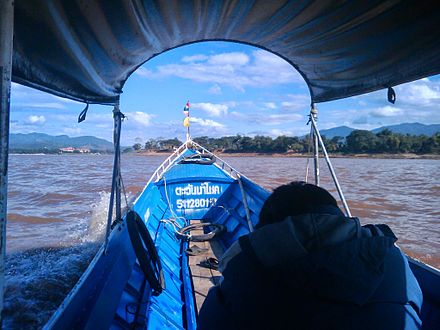Chiang Saen - district in Chiang Rai province, Thailand

 Chiang Saen (เชียงแสน) is a city in Chiang Rai Province, just south of the Golden Triangle.
Chiang Saen (เชียงแสน) is a city in Chiang Rai Province, just south of the Golden Triangle.
Understand
Once one of the major cities of the Lanna kingdom, it was originally called Wiang Hiran Nakhon Ngoen Yang and served as the capital before King Mengrai established Chiang Rai in 1262. The town was captured by the Burmese in the 16th century and sacked by King Rama I in 1803. Left a ghost town for a hundred years, it was repopulated around 1900, but still hasn't really staggered to its feet. Traces of old double city walls and many other antiquities still remain in and outside the town.
Get in
By bus
Chiang Saen is connected by local bus to Chiang Rai (2-2.5 hrs, nominally. 3-4 per hour but tend to depart when reasonably full, 37 baht). There are a few, 3-4 per day, long-distance buses which can do the trip in 1.5 hrs, but times are more convenient for long-distance journeys such as going to or from Chiang Mai or Bangkok than for commuting to Chang Rai. Blue songthaews also travel from Mae Sai via the Golden Triangle to Chiang Saen in about 1 hour. The timetable for this service is chalked up at the depot which is next to the bus stop. These seem to depart every half hour or so. The service from the Golden Triangle to Chiang Saen seems to be much more irregular. The service varies with customers available and the flow of life along the Mekong and the Myanmar border.
The bus station and songthaew depot is about 50 m before the main road (Hwy 1016) ends in a T-intersection on the banks of the Mekong River.
There does not appear to be any regular public transport south to Chiang Khong and the Lao border crossing, apart from the occasional songthaew. Ask locally for details of this service as departures times vary.
By car
The district can be reached by taking Hwy 110 from Chiang Rai for some 30 km. Then take a right turn onto Hwy 1016 and proceed on for another 30 km.
By boat
It's possible to charter a boat carrying up to 8 people along the Mekong to Chiang Khong (1.5 hr) for around 1,500 baht, or up to Sop Ruak (Golden Triangle) for less (around 40 min).
Get around
See
 Like Chiang Mai, Chiang Saen has a city wall surrounding the historic town, with the fourth "wall" provided by the Mekong River.
Like Chiang Mai, Chiang Saen has a city wall surrounding the historic town, with the fourth "wall" provided by the Mekong River.
- Chiang Saen Lake (ทะเลสาบเชียงแสน). A large natural reservoir with scenic surroundings. Large flocks of waterfowl immigrate to the site during winter.
- Chiang Saen National Museum (พิพิธภัณฑสถานแห่งชาติเชียงแสน), +66 53 777102. W-Su, 09:00-16:00.. Archaeology, settlements and history of the town. There are replicas of the community and scores of ancient relics including Lanna-style sculptures, Buddha statues and inscription stones from Phayao and Chiang Saen itself. In addition, there are exhibitions of indigenous art objects of the Thai Yai (ไทยใหญ่), Thai Lu (ไทยลื้อ) and other hill tribes. These items include musical instruments, ornaments, opium-smoking accessories.
- Wat Pa Sak (วัดป่าสัก). Built by King Saen Phu in 1295 when three hundred teak trees were planted, hence the name Pa Sak (teak wood). It was then the residence of the patriarch. The temple's chedi is beautiful in Chiang Saen-style and the exteriors are elaborately decorated with designs. The chedi itself measures 12.5 m tall with a base of 8 m width, enshrined with the Lord Buddha's relics.
- Wat Phra Chao Lan Thong (วัดพระเจ้าล้านทอง). Built by Prince Thong Ngua, a son of King Tilokkarat, the 12th ruler of Lanna, in 1489. A 1,200 kg Buddha statue was cast, 2 m wide and over 3 m high, named Phra Chao Lan Thong. Another Buddha statue called Phra Chao Thong Thip was also cast which is made of brass in Sukhothai-style.
- Wat Phra That Chedi Luang (วัดพระธาตุเจดีย์หลวง). Built by King Saen Phu, the 3rd ruler of the Lanna kingdom in the early 13th century. Ancient sites include the bell-shaped, Lanna-style principal chedi, measuring 88 m in height with a base of 24 m width, the largest structure in Chiang Saen. There are also remains of ancient viharn and chedi.
- Wat Phra That Pha Ngao (วัดพระธาตุผาเงา). There is a bell-shaped chedi standing on large boulders. Nearby is a viharn where several old Chiang Saen-style Buddha statues are enshrined. There is also a viewpoint overlooking the Mekong and Chiang Saen. The temple attracts many Thai visitors. Part of the temple was found to be at least 700-1,300 years old. The temple has welcomed the royal family on many occasions over the last few decades.
There are also several ancient sites outside the city wall including Wat Phra That Pha Ngao (วัดพระธาตุผาเงา), a place for dharma practice. Wat Chedi Ched Tod (วัดเจดีย์เจ็ดยอด) is a peaceful place, 1 km beyond Wat Phra That Pha Ngao. Wat Phra That Chom Kitti (วัดพระธาตุจอมกิตติ), about 1.7 km from town, and Wat Sangkha Kaeo Don Han (วัดสังฆาแก้วดอนหัน) where sketches on brick slabs tell stories about the life of the Lord Buddha.
Do
- Songkran Festival and Boat Races (งานประเพณีสงกรานต์และแข่งเรือเมืองเชียงแสน). Held 13-18 Apr every year. In this festival, there is a parade featuring the water bathing ceremony of the Phrachao Lanthong Buddha image. There are also boat races and folk performances.
- Loi Krathong Festival The festival day usually falls in the month of November depending on the Thai lunar calendar.

Buy
Eat

 In the evening, many local food stalls set up shop along the bank of the Mekong north of the T-junction. The tables set are small, and you sit on a mat on the ground as locals do. Menu in English and Thai. Try the bamboo chicken and/or bamboo fish (cooked inside bamboo on charcoal fires).
In the evening, many local food stalls set up shop along the bank of the Mekong north of the T-junction. The tables set are small, and you sit on a mat on the ground as locals do. Menu in English and Thai. Try the bamboo chicken and/or bamboo fish (cooked inside bamboo on charcoal fires).
If you walk north beyond the night market, to where the road turns away from the river, there are several eateries sharing a covered terrace above the river. Parking is available. These provide a cafe/basic restaurant setting. The food available at all these outlets is excellent value with a similar but not identical set of standard dishes to choose from at each outlet. The quality is more than adequate, more basic good value rather than exquisite, but the dishes are well-prepared, cooked to order, and taste authentic. The service is pleasant and the beer is cold. The cooks take pride in their work
There is a small restaurant opposite the new banking establishments halfway down the main drag (on your left as you face the river). The food is perfectly adequate and one will not be disappointed. The value is good and the beer is cold. The service is good and the owners are trying hard.
Drink
Sleep
Accommodations in Chiang Saen are limited. Fancier digs are to be found in the Golden Triangle, just north of Chiang Saen.
- Chiang Saen Guesthouse.
- Chiang Saen River Hill Hotel. A mid-range option. The rooms are well furnished, of reasonable size and the staff are both friendly and helpful. The hotel flows with the passing of tour groups. Should a large tour group turn up while you are there, you could feel neglected as the staff struggle to cope. A very noisy karaoke party might keep you awake if your room is immediately over the restaurant/bar area, but the hotel tries to wind these down by 22:00. Sadly hotels like these must accommodate the tour groups idea of a good time so some bad reviews might just reflect a bad tour group. Left to its own devices this hotel is an excellent and good value mid-range option. Wi-Fi is available in the lobby area. 900 baht
- Mekong Sunshine Resort (Baan Rot Fai), 155 Chiang Saen-Chiang Khong Rd, Wiang (On the Mekong River and on the main street. South of the T-intersection (turn right).), +66 81 8465059. Check-in: Anytime, check-out: 12:00. Borders the Mekong River and offers views of Laos and Myanmar. The tranquil atmosphere and warmhearted service guarantees complete relaxation. All rooms offer priceless scenery. Choose from basic, clean bedrooms ranging from 800 baht to the exotic, exclusive WWI-era train cabin room. Two Thai-style villas, with one and two bedrooms respectively, each with a kitchen, are perfect for families. Walk-in rates seem high. 800 baht
- Sa Nae Charn Guesthouse. Fan room from 250 baht
- Tankun Hostel. Free Wi-Fi, coffee. dorm, 99 baht
- Anantara Golden Triangle Elephant Camp & Resort, 229 Moo 1, Chiang Saen, 20.367288°, 100.07754°, +66 53 784 084, goldentriangle@anantara.com. Guests can trek through the jungle on the back of an elephant. includes a spa, restaurants and a swimming pool. 63 rooms and suites. Starting from US$708 2017-02-21
Connect
Go next
- Chiang Khong, for the border crossing to Laos
- Chiang Rai, the largest city in these parts
- Golden Triangle, the point where Thailand, Myanmar, and Laos meet
- Mae Sai, Thailand's northernmost city
- Ferry along the Mekong between the borders of Laos and Myanmar (no visas required for these two countries) to Jinghong, China
Chiang Saen
Postal code:57150Date Time:Please wait...Timezone:Asia/BangkokPopulation:54,134Coordinates:20.27, 100.09
Chiang Rai
Primary administrative division